|
Historical Information

Situated approximately 6.5 miles north of Potter Point, Middle Island
received its name as a result of its location midway between the North
Point of Thunder Bay and Presque Isle. The island had long represented a
"triple-edged sword" to mariners. Marking a turning point in
the course for vessels making up and down the coast, the island's lee
side also represented an excellent harbor of refuge in which to escape
Huron's fury. However surrounded with shoals with depths of less than
six feet on all but its northeast side, the refuge could be hard to find
in dark of night or in the thickest weather. In fact, the area was
considered dangerous enough that the Life Saving Service built a station
on the island in 1881 to help service ships in distress in the area.
 As one of the final links in a growing
chain of coast lights being constructed along Huron's western shore, the
Lighthouse Board finally recommended that an appropriation of $25,000 be
made for a light and fog signal on the Middle Island's eastern shore in
its annual report of 1896. With no appropriation forthcoming, the Board
reiterated its request in each of its annual reports for the following
six years, until Congress finally responded favorably with the requested
appropriation on March 3, 1902. As one of the final links in a growing
chain of coast lights being constructed along Huron's western shore, the
Lighthouse Board finally recommended that an appropriation of $25,000 be
made for a light and fog signal on the Middle Island's eastern shore in
its annual report of 1896. With no appropriation forthcoming, the Board
reiterated its request in each of its annual reports for the following
six years, until Congress finally responded favorably with the requested
appropriation on March 3, 1902.
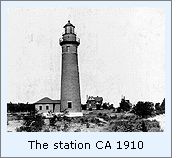 The site was surveyed and preparations
for construction began the following year, with the contract for the
construction of the tower, double keepers dwelling and fog signal
awarded early in 1904. The lighthouse tender AMARANTH delivered
materials and a working party on the island on June 11, and work
on the tower, dwelling and fog signal began immediately, all of which
were constructed of brick on dressed stone foundations. Work continued
through the 1904
season of navigation until winter's icy grip forced the crew to secure
the buildings and abandon the station for the winter. The site was surveyed and preparations
for construction began the following year, with the contract for the
construction of the tower, double keepers dwelling and fog signal
awarded early in 1904. The lighthouse tender AMARANTH delivered
materials and a working party on the island on June 11, and work
on the tower, dwelling and fog signal began immediately, all of which
were constructed of brick on dressed stone foundations. Work continued
through the 1904
season of navigation until winter's icy grip forced the crew to secure
the buildings and abandon the station for the winter.
 The
AMARANTH returned to the island
soon after the opening of navigation in 1905 along with the working
party, the iron work for the tower and the fog-signal apparatus, both of
which had been completed under contract during the preceding winter.
With work on the large two story red brick duplex keepers dwelling
completed on April 26, the crew turned its attention to the tower and
fog-signal buildings. The
AMARANTH returned to the island
soon after the opening of navigation in 1905 along with the working
party, the iron work for the tower and the fog-signal apparatus, both of
which had been completed under contract during the preceding winter.
With work on the large two story red brick duplex keepers dwelling
completed on April 26, the crew turned its attention to the tower and
fog-signal buildings.
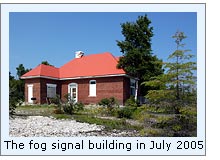 The red brick fog-signal building was
equipped with duplicate 10-inch steam powered fog whistles with a
prescribed repeated 20-second cycle consisting of a
3-second blast followed by 17-seconds of silence. The unpainted buff
brick tower stood 70 feet from the foundation to the center of the
ten-sided iron lantern, and 80 feet to the top of the ventilator ball.
The tower's location on a slight rise provided the fixed red Fourth
Order Fresnel lens with a focal plane of 78 feet, with the 3,700
candlepower lamp providing a visibility range of 17 miles. An attached
service room at the base of the tower provided space for storage and
maintenance of the illuminating apparatus. A frame boathouse and landing,
along with a red brick outhouse rounded-out the station's complement of
buildings. A tramway system was installed from the landing to the
fog-signal and service room for the transportation of coal, kerosene and
supplies. The red brick fog-signal building was
equipped with duplicate 10-inch steam powered fog whistles with a
prescribed repeated 20-second cycle consisting of a
3-second blast followed by 17-seconds of silence. The unpainted buff
brick tower stood 70 feet from the foundation to the center of the
ten-sided iron lantern, and 80 feet to the top of the ventilator ball.
The tower's location on a slight rise provided the fixed red Fourth
Order Fresnel lens with a focal plane of 78 feet, with the 3,700
candlepower lamp providing a visibility range of 17 miles. An attached
service room at the base of the tower provided space for storage and
maintenance of the illuminating apparatus. A frame boathouse and landing,
along with a red brick outhouse rounded-out the station's complement of
buildings. A tramway system was installed from the landing to the
fog-signal and service room for the transportation of coal, kerosene and
supplies.
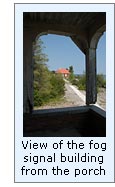 With the pouring of concrete sidewalks
between all structures, work on the station was completed, and the light
exhibited for the first time on the evening of June 1, 1905. During that
fall and the following spring, the fog signal was operated for a total
of 157 hours, its boilers consuming some 11 tons of coal. With the pouring of concrete sidewalks
between all structures, work on the station was completed, and the light
exhibited for the first time on the evening of June 1, 1905. During that
fall and the following spring, the fog signal was operated for a total
of 157 hours, its boilers consuming some 11 tons of coal.
The following year, the
AMARANTH
returned to deliver another work crew and materials for the construction
of a brick 500-gallon capacity oil storage building and a frame
woodshed.
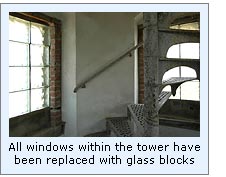 By 1928, the station's illuminating
apparatus had been upgraded to a 9,000 candlepower electrically powered
isophase green Third Order Fresnel lens with a characteristic cycle of
alternating 5-second periods of light and dark. The fog-signal was
likewise upgraded through the installation of a compressed air-powered
diaphone fog signal with a revised 20-second cycle, consisting of a 2-second blast
followed by 18-seconds of silence. By 1928, the station's illuminating
apparatus had been upgraded to a 9,000 candlepower electrically powered
isophase green Third Order Fresnel lens with a characteristic cycle of
alternating 5-second periods of light and dark. The fog-signal was
likewise upgraded through the installation of a compressed air-powered
diaphone fog signal with a revised 20-second cycle, consisting of a 2-second blast
followed by 18-seconds of silence.
With the assumption of responsibility
for aids to navigation assumed by the Coast Guard in 1939, the tower was
painted white with a horizontal black band around the center in order to
increase its effectiveness as a day-mark. Recounting the Inspector's
annual visit to the Island in 1958, retired Coast Guardsman Bill
Leveille recalls the Inspector asking the station crew if they would
consider painting the light themselves. On hearing that the crew was
unanimously afraid of working at such heights, the Inspector then
asked how much it would cost to hire a private contractor to come to the
island to do the job. On hearing from Ray Demarco that a quotation had
been obtained for $1,400, the Inspector pondered the situation for a few
moments, and then asked if the boys would be willing to do the work for
$1,000. Being that $1,000 was a lot of money in 1958, the crew
immediately agreed to tackle the job, to which the Inspector responded
"Well boys, that's all I wanted to know - You're in the Coast Guard, and
it's part of your job - start painting!" Imagine the enjoyment of
swinging in the wind at the end of a rope suspended from the gallery,
painting that black band.
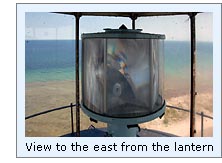 At some time that we have yet been able
to determine, the black band was painted-over with the bright red band seen on the tower today, and the work of the many keepers assigned
to the station was hidden from the world. At some time that we have yet been able
to determine, the black band was painted-over with the bright red band seen on the tower today, and the work of the many keepers assigned
to the station was hidden from the world.
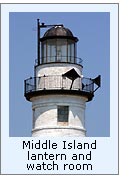 After automation, the station was
significantly vandalized by marauding pleasure boaters during the
1960's, and the keeper's dwelling was completely stripped of just about
everything removable. With the station decaying and in danger of further
deterioration, a group of concerned citizens in the Alpena area
incorporated the Middle Island Lighthouse Keepers Association on
February 13, 1992, with the express purpose of restoring and preserving
the structures and the history of the station for future generations. After automation, the station was
significantly vandalized by marauding pleasure boaters during the
1960's, and the keeper's dwelling was completely stripped of just about
everything removable. With the station decaying and in danger of further
deterioration, a group of concerned citizens in the Alpena area
incorporated the Middle Island Lighthouse Keepers Association on
February 13, 1992, with the express purpose of restoring and preserving
the structures and the history of the station for future generations.
To this end, the Association has been
restoring the fog signal building for use as a bed and breakfast inn,
until the large keepers dwelling can be restored and converted to a
similar purpose. The Middle Island Bed & Breakfast opened for
business in 2001.
Thus, we are happy to report that the
future of this station appears secure for future generations to enjoy.

Keepers of
this Light

Click here
to see a complete listing of all Middle Island Light keepers compiled by
Phyllis L. Tag of Great Lakes Lighthouse Research.

Finding this
Light

Middle Island Boat Tours takes
lighthouse aficionados on 3 ½-hour trips to the island, in which an
island nature walk and tour of the restoration effort are featured. For
more information, contact:
Middle Island Bed and Breakfast
5671 Rockport Road - Middle Island
Alpena, MI 49707

Reference
Sources

 USCG Historian's Office - photographic archives. USCG Historian's Office - photographic archives.
Annual Reports of the Lighthouse Board,
various 1896 - 1909
Great Lakes Light Lists,
1924, 1949 & 1953
Coast Pilot 6,
Great Lakes, NOAA, 2000
Lake Pilot's Handbook,
Captain George Trimble, 1907
09/10/01 email from Bill
Leveille
Inventory of Historic Light Stations,
NPS, 1994.
Keeper listings for this light appear courtesy of Tom & Phyllis Tag
|
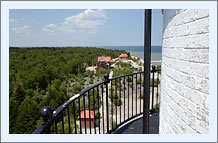

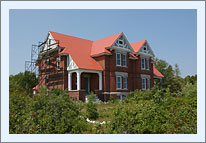
 As one of the final links in a growing
chain of coast lights being constructed along Huron's western shore, the
Lighthouse Board finally recommended that an appropriation of $25,000 be
made for a light and fog signal on the Middle Island's eastern shore in
its annual report of 1896. With no appropriation forthcoming, the Board
reiterated its request in each of its annual reports for the following
six years, until Congress finally responded favorably with the requested
appropriation on March 3, 1902.
As one of the final links in a growing
chain of coast lights being constructed along Huron's western shore, the
Lighthouse Board finally recommended that an appropriation of $25,000 be
made for a light and fog signal on the Middle Island's eastern shore in
its annual report of 1896. With no appropriation forthcoming, the Board
reiterated its request in each of its annual reports for the following
six years, until Congress finally responded favorably with the requested
appropriation on March 3, 1902. The site was surveyed and preparations
for construction began the following year, with the contract for the
construction of the tower, double keepers dwelling and fog signal
awarded early in 1904. The lighthouse tender
The site was surveyed and preparations
for construction began the following year, with the contract for the
construction of the tower, double keepers dwelling and fog signal
awarded early in 1904. The lighthouse tender  The
AMARANTH returned to the island
soon after the opening of navigation in 1905 along with the working
party, the iron work for the tower and the fog-signal apparatus, both of
which had been completed under contract during the preceding winter.
With work on the large two story red brick duplex keepers dwelling
completed on April 26, the crew turned its attention to the tower and
fog-signal buildings.
The
AMARANTH returned to the island
soon after the opening of navigation in 1905 along with the working
party, the iron work for the tower and the fog-signal apparatus, both of
which had been completed under contract during the preceding winter.
With work on the large two story red brick duplex keepers dwelling
completed on April 26, the crew turned its attention to the tower and
fog-signal buildings. The red brick fog-signal building was
equipped with duplicate 10-inch steam powered fog whistles with a
prescribed repeated 20-second cycle consisting of a
3-second blast followed by 17-seconds of silence. The unpainted buff
brick tower stood 70 feet from the foundation to the center of the
ten-sided iron lantern, and 80 feet to the top of the ventilator ball.
The tower's location on a slight rise provided the fixed red
The red brick fog-signal building was
equipped with duplicate 10-inch steam powered fog whistles with a
prescribed repeated 20-second cycle consisting of a
3-second blast followed by 17-seconds of silence. The unpainted buff
brick tower stood 70 feet from the foundation to the center of the
ten-sided iron lantern, and 80 feet to the top of the ventilator ball.
The tower's location on a slight rise provided the fixed red  With the pouring of concrete sidewalks
between all structures, work on the station was completed, and the light
exhibited for the first time on the evening of June 1, 1905. During that
fall and the following spring, the fog signal was operated for a total
of 157 hours, its boilers consuming some 11 tons of coal.
With the pouring of concrete sidewalks
between all structures, work on the station was completed, and the light
exhibited for the first time on the evening of June 1, 1905. During that
fall and the following spring, the fog signal was operated for a total
of 157 hours, its boilers consuming some 11 tons of coal. By 1928, the station's illuminating
apparatus had been upgraded to a 9,000 candlepower electrically powered
isophase green
By 1928, the station's illuminating
apparatus had been upgraded to a 9,000 candlepower electrically powered
isophase green  At some time that we have yet been able
to determine, the black band was painted-over with the bright red band seen on the tower today, and the work of the many keepers assigned
to the station was hidden from the world.
At some time that we have yet been able
to determine, the black band was painted-over with the bright red band seen on the tower today, and the work of the many keepers assigned
to the station was hidden from the world. After automation, the station was
significantly vandalized by marauding pleasure boaters during the
1960's, and the keeper's dwelling was completely stripped of just about
everything removable. With the station decaying and in danger of further
deterioration, a group of concerned citizens in the Alpena area
incorporated the Middle Island Lighthouse Keepers Association on
February 13, 1992, with the express purpose of restoring and preserving
the structures and the history of the station for future generations.
After automation, the station was
significantly vandalized by marauding pleasure boaters during the
1960's, and the keeper's dwelling was completely stripped of just about
everything removable. With the station decaying and in danger of further
deterioration, a group of concerned citizens in the Alpena area
incorporated the Middle Island Lighthouse Keepers Association on
February 13, 1992, with the express purpose of restoring and preserving
the structures and the history of the station for future generations. USCG Historian's Office - photographic archives.
USCG Historian's Office - photographic archives.